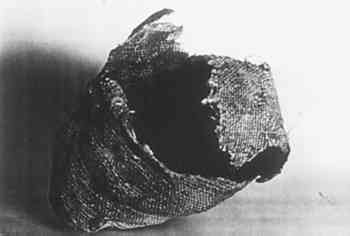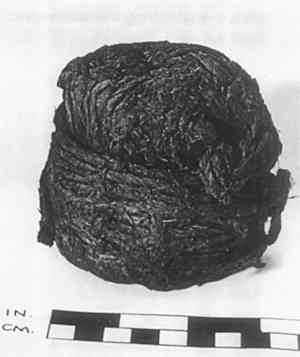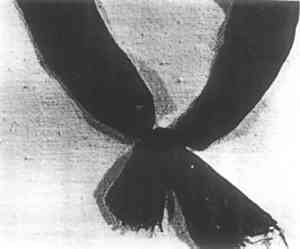CONSERVATION OF LEATHER AND TEXTILES FROM THE DEFENCE
Kenneth Morris, & Betty L. Seifert
6 TREATMENT OF THE SHOT BAG
INVESTIGATIONS WERE INITIATED on samples of textiles similar in fibre content and structure to the artifact. After testing was completed, the following steps were instituted: removal of metal salts, immersion, and drying.
Removal of metal salts: The removal of metal salts has been previously discussed (see removal of metal salts in the Leather Section of this paper). It was found that by using a 5% (w/v) aqueous solution of oxalic acid metallic encrustations could be significantly reduced in most textiles over a short time period (e.g. 1–2 days). The shot bag required a longer time, 15 days. Following this salt removal, the fabric was thoroughly washed with tap water for a week.
Several years ago, a new preservative compound (Modocol) was introduced for archaeological materials.14 Its purpose was to provide support and flexibility for an archaeological textile. More recently, a similar mixture of Ethulose, PEG 400, and a fungicide has been employed for the stabilization of other archaeological materials.15 The use of these two methods of stabilization on DEFENCE textile samples caused them to become unacceptably brittle.
Immersion and drying: To overcome the rigidity, tests were once again initiated. It was found that as a precursor to freeze drying, immersion in an aqueous solution of 1% (w/v) Ethulose and 5% PEG 400 would leave the fabric flexible. At the same time, it was consolidated. To prevent gross fibre collapse, the textiles were frozen (−18�C) and then freeze-dried following the same procedure as for leather (Fig. 5).
Fig. 5.
Shot bag after treatment.
 |
Ropes and wadding were found to need an additional treatment step. The freezing of the artifacts was interrupted at the point of “jelling.” This term refers to the state when the cords or lines and their fibres are still manipulatable in the highly viscous impregnating medium. These artifacts were removed from the net casings and while held in place by the jelled solution, the individual cords of the rope or wadding were separated to reduce the matted effect of loose fibres (see Figs. 6 and 7).
Fig. 6.
Matted ball of wadding.
 |
Fig. 7.
Specially treated wadding (jelling) and arranging of fibres.
 |
Protective mounting: In some cases, the textiles needed physical support after their consolidation. Using conventional methods, washed unbleached muslin was stretched over a sealed wooden strainer for a textile mount. In some cases, the textile to be mounted was first sewn to nylon net and then the net was mounted on the muslin (see Fig. 8).16,17
Fig. 8.
Ribbon on muslin.
 |
|



